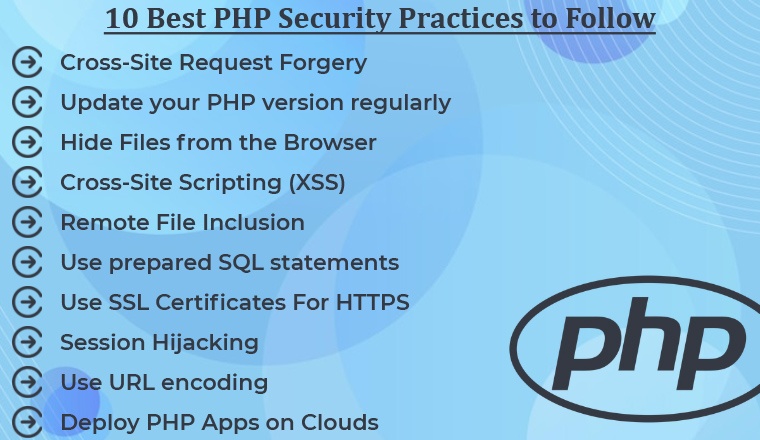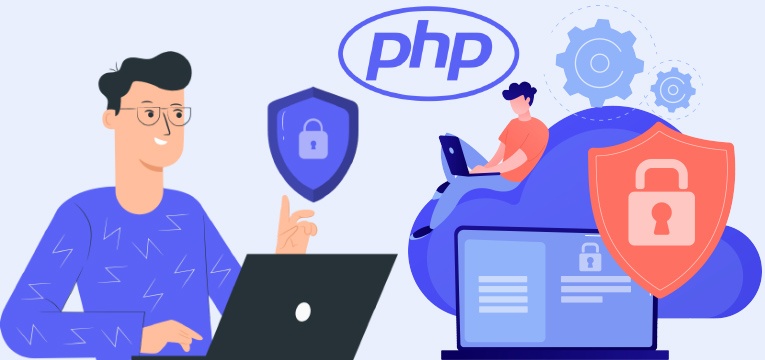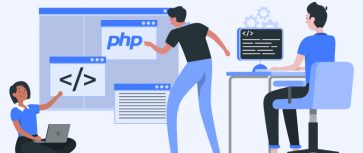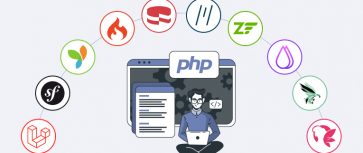Table of Content
Top 10 PHP Security Best Practices
Since PHP is the core of nearly every web application around the internet, PHP security issues must under no circumstances be regarded as unimportant. PHP programmers have the ability to eliminate typical dangers such as cross-site request forgery, SQL injections, and sensitive data breach. This entire process of security is possible by PHP’s built-in safety features, which make web application encryption easier for programmers, but it comes with good practice. Therefore, when you hire PHP developers from India or any other region, you must evaluate them on their consistency in following the PHP security best practices.
If you are not familiar then in this blog post, we have tried to cover as many best practices as possible. Keep reading!
1. 10 Best PHP Security Practices to Follow

A web developer’s primary responsibility is to protect online programs and infected codes against all types of fabricated attacks. You should build your PHP web applications so that there is zero security flaw or problem.
Globally, PHP is the most used server-side web programming language. Various PHP applications exchange portions of their scripting and programming with other online applications. If you discover the shared portion of code to be insecure or malicious, any programs that use it will be at threat and deem insecure.
We know the repercussions; now, let us talk about some of the best practices, which is our main topic of discussion.
Further Reading:
What is PHP Application Development?
1.1 Cross-Site Request Forgery
One of the most useful PHP security best practices, CSRF allows intruders to complete application control, enabling them to do any undesirable action. With total control, hackers can execute malicious operations on the website by delivering malicious code, causing data breaches, functional changes, and other negative effects. The vulnerability compels users to submit malicious requests, including unintentionally transferring money or erasing the whole database without their knowledge.
One can initiate he CSRF attack only if you engage in the hacker’s masked, malicious link. If you are knowledgeable enough to determine the position of the corrupted concealed codes, you can rapidly eliminate a CSRF attack. In the meantime, you may increase the security of the web application by employing two preventive measures: adding GET inquiries in the URL and assuring that non-GET queries occur entirely from client-side code.
1.2 Update Your PHP Version Regularly
The latest version of PHP, as of August 7, 2022, is 8.1.8. It is essential to regularly upgrade your PHP version, as the latest versions typically contain bug fixes for identified security loopholes. If you choose to not update to the most recent stable version of PHP, attackers can use known security vulnerabilities in prior editions.
Furthermore, PHP permits the testing of preview releases. Nevertheless, security professionals urge organizations to avoid testing preview releases because they may potentially involve unknown security issues.
1.3 Hide Files from the Browser
If you’ve worked with PHP micro-frameworks, you should be familiar with the directory arrangement that assures the correct location of the root documents. Frameworks permit having configuration files such as control systems, databases, root setup file(.yaml), etc., inside this directory. However, the web browser often does not read all the data, despite their visibility in the browser. To overcome this difficulty, you must store your documents in a shared folder rather than the root directory so that those are not always visible by the web browser.
1.4 Cross-Site Scripting (XSS)
Cross-site scripting attack, or XSS attack, relates to the unintended activation of external code by the online app. An XSS attack may happen, for example, if your online application accepts user input and instantly displays it on the website page. The external code runs when a malevolent user adds HTML, JavaScript, or even CSS to your app.
The sample below includes a form that receives user input.
<form action=”form.php” method=”post”> <input type=”text” name=”message” value=””> <input type=”submit” name=”submit” value=”Submit message”> </form> Now, immediately output the entered data to the web page. <?php echo $_POST[“message”]; |
A malicious intruder nowadays can introduce JavaScript using this method. The user may, for example, enter a script tag holding an alert code that will be run by a web application.
<script>alert(“Hacker was here”)</script> |
The accompanying script component will cause the browser to show a simple alert text. This could seem to be harmless. A malicious user may easily steal sensitive personal information or the information of other users.
What are the preventive measures? Guarantee that every unsecure user input is encoded to minimize remote code execution and avoid cross-site scripting XSS attacks.
1.5 Remote File Inclusion
Distant file inclusion is one of the PHP security best practices of incorporating remote files into a program. Quite insightful, right? But why does this matter? The reason behind this is, the remote file is not trustworthy because it comes from unknown sources. It’s possible that it was altered maliciously to add a script that you do not want your program to execute.
Suppose that the script.php library from www.xyz.com has been included in the www.abc.com website. One evening, www.xyz.com is hacked, and the data of the documents are swapped with malicious programs that will damage your web application. Then a user enters your website, you modify the code, and voila! Consequently, how can you stop it?
Thankfully, this issue is trivial to resolve. Simply browse to the php.ini configuration file and confirm the values for the flags.
- allow_url_fopen – Indicates whether remote files can be used. This is enabled by default, but you desire to deactivate it.
- allow_url_include – Indicates if the include(), require(), include once(), and require_once() methods are permitted to access remote files. This is deactivated by default and may be disabled by enabling allow_url_fopen.
1.6 Use Prepared SQL Statements
Inserting user input straight into an intended SQL query is a common blunder. This enables SQL injection attacks, wherein the user may evade the specified standardized requests and execute arbitrary SQL queries.
The request below, for example, incorporates unfiltered user input right into the SQL query.
$users = mysql query("SELECT * FROM "users" WHERE "id" = "$_GET[id]"); |
This allows an attacker to evade the statements and inquire for additional confidential material, including all user information. The data is inserted using a predefined SQL statement that is evacuated, essentially removing the potential of a SQL injection attack.
Take the scenario below, which utilizes a prepared statement.
$stmt = $conn-> prepare(“INSERT INTO users (firstname, lastname) VALUES (?, ?)”); $stmt->bind_param(“ss”, $firstname, $lastname); |
Take notice of the initial input of the bind param technique. This informs the SQL query about the kind of information being provided. Both the firstname and lastname inputs are String types in the particular scenario. This is an extra security measure that checks the data type of the input.
1.7 Use SSL Certificates For HTTPS
Always use SSL certificates to secure end-to-end data transfer over the web in the apps. Hypertext Transfer Protocol Secure (HTTPS) is a globally famous standard procedure for safely transmit data across web servers. By utilizing an SSL certificate, your program obtains access to a safe data transmission route, minimizing the risk of attackers penetrating your servers.
All major web browsers, such as Google Chrome, Safari, Firefox, and Opera, recommend using an SSL certificate because it permits the transfer, reception, and decryption of sensitive information across the web.
1.8 Session Hijacking
Session hijacking the act of stealing and using another user’s session ID, which acts equivalent to a secure storage box key. PHP maintains the session ID in a client-side cookie, more commonly called PHPSESSID, whenever a client and a web server create sessions. By adding the ID in the page’s query, you may access the server-persistent session data.
Is it a negative thing if a session key is stolen? And the reply would be no if you are not achieving anything noteworthy during that period. Nevertheless, if you utilize that session to verify a user, a malicious person would be able to obtain entry to the system. This is particularly risky if the user is notable and holds a great deal of authority.
How therefore can such session IDs be hijacked, and what can terrified individuals do to prevent it?
Session IDs are routinely stolen through XSS attacks; therefore, safeguarding them is advantageous for both parties. In particular, it is essential to upgrade the session ID as often as feasible. This decreases your opportunities for theft. The session renews id() function may be used from inside PHP to refresh the session ID and notify the user.
There is a php.ini feature for users of PHP5.2 or above that blocks JavaScript from obtaining the session id (session.cookie.httponly). Alternatively, you can use the session set cookie params().
If you utilize common hosting platforms that store session data in publicly available areas like /tmp, session IDs are also vulnerable on the server side. To prevent this difficulty, just save the session ID in a place that only your programs may reach, either on the drive or in databases.
1.9 Use URL Encoding
The URL Encode functionality provided by PHP enables developers to generate valid URLs securely. Based on the PHP documentation, the approach may be used to encode a string for usage in the request part of a URL.
Assume a scenario in which a URL is generated using user input. In such cases, the urlencode function can be used to generate a secure URL.
<?php echo 'a href="mylink?user=', $userID, '">'; ?> |
1.10 Deploy PHP Apps on Clouds
Hosting is the ultimate and most crucial step in constructing any application online, considering that you generally begin with local PHP servers before migrating to live servers that provide shared, cloud, or dedicated hosting. Experts often recommend cloud hosting companies like DigitalOcean, Linode, and AWS. In addition, they offer a protective layer to shield web apps from DDoS, brute force, and phishing threats.
To launch PHP web applications on cloud servers, you should have solid Linux knowledge to build powerful web stacks, including LAMP or LEMP, which typically need extra time and funds for Linux experts. Instead, Cloudways’ controlled PHP and MySQL server solutions allow you to set up Thunderstack servers using a few steps on the aforementioned cloud providers. Thunderstack safeguards the PHP application from a multitude of malicious attacks and provides peak efficiency.
2. Conclusion
PHP applications are usually susceptible to external security vulnerability, but with the aforementioned PHP security best practices, you may simply safeguard the software’s cores against any malicious attack. As a software developer, it is your obligation to keep your app’s data secure and error-free.
In addition to these security best practices, there are several ways that may help you protect your online app from external threats, such as utilizing the finest cloud hosting provider that assures you have the greatest security tools, cloud WAF, documentation root setting, and IP whitelisting.
3. Frequently Asked Questions
Q:1 How do you test PHP security?
A: There are several code scanners in the industry that may assist you to evaluate the integrity and safety of the PHP code in your apps. PHP Malware Finder (PMF) is among the most effective security testing tools for locating harmful code in documents. You may also utilize RIPS, a prominent code analysis tool that identifies code risks in real-time.
Q:2 How to ensure PHP database security?
A: To guarantee security controls, you must always use measures such as SQL injection prevention, database firewalls, and routine data encryption.
Q:3 Which way of encrypting passwords in PHP is secure?
A: Md5 stands for Message Digest 5, whereas SHA-1 stands for Secure Hash Algorithm 1. Both are employed to encrypt strings. When a string is encrypted, decoding it becomes tedious. MD5 and SHA-1 are extremely handy for storing credentials in databases.
Q:4 What is a PHP vulnerability?
A: PHP Object Injection is an application-level flaw that appears to allow for a variety of malicious attacks, including Code Injection, SQL Injection attacks, Path Traversal, and Denial of Service.
Several computer networks are compromised by DDoS strikes. Common targets include servers, sites, and other shared networks.
This occurs when user don’t control input prior sending to the unserialize() PHP function. As PHP supports object serialization, attackers can send arbitrary encoded strings to an unprotected unserialized() operation.

Hardik Dhanani has a strong technical proficiency and domain expertise which comes by managing multiple development projects of clients from different demographics. Hardik helps clients gain added-advantage over compliance and technological trends. He is one of the core members of the technical analysis team.
PHP (Hypertext Preprocessor) and JavaScript are among the most significant web development server side technologies that have existed for more than 20 years, with the...
 Oct 3, 2022
Oct 3, 2022 



Security is the most essential thing to consider while developing any web applications. PHP is a robust JS programming language, it provides various inbuilt security options but you did a good job by providing the list of PHP security best practices. Now on will check all the security threats before deploying an app. Thanks!
Thanks for sharing these amazing PHP security best practices. But you can also add some security tips like "Create A Custom Admin Path", "Monitoring File Changes" and "Disable Directory Indexing". Thanks!